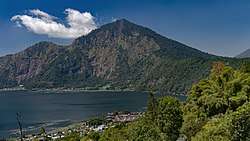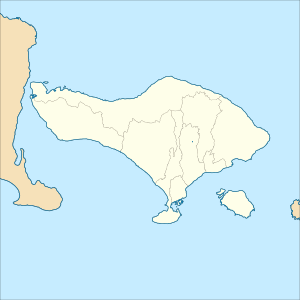Lake Batur
Lake Batur is a volcanic crater lake in Kintamani, Bali, Bangli Regency of Bali, located about 30 km (19 mi) northeast of Ubud in Bali. The lake is inside of the caldera of an active volcano, Mount Batur, located along the Ring of Fire of volcanic activity.
| Lake Batur | |
|---|---|
 | |
 Lake Batur | |
| Location | Kintamani, Bali, Bangli Regency, Bali, Indonesia |
| Coordinates | 08°15′30″S 115°24′30″E |
| Type | Polymictic, Volcanic crater lake |
| Max. length | 2.5 km (1.6 mi) |
| Max. width | 7.5 km (4.7 mi) |
| Surface area | 15.9 km2 (3,900 acres) |
| Max. depth | 88 m (289 ft)[1] |
| Water volume | 0.82 km3 (660,000 acre⋅ft) |
| Surface elevation | 1,031 m (3,383 ft) |
Geography
Lake Batur lies south-east of the active Mount Batur volcano, inside the older Batur caldera.
Bathymetry
The deepest point in the lake is around 88 meters.[2]
Watershed
Inflow from agriculture
The Batur caldera is an important agricultural area, with cultivation of a wide range of produce. The irrigation water flows back into the lake after it has been pumped up, bringing with it nutrients to the lake body.
Inflow from hot springs
In the village of Toya Bungkah, there are several hot springs related to the volcanic activity of the Mount Batur volcano. These have been developed for tourism purposes.[3] The water from these hot springs flow into the lake.
Aquaculture
The Batur lake have been in recent years, farmed for fish. The Nile tilapia was the dominant species in the lake when a study was undertaken in 2011.[4] The local name for the fish is Ikan Mujair.
Fish death
On the morning of 19 June 2011, greenish-white spots emerged on the surface of the lake. These spots later merged, stretching from Toya Bungkah to Buahan. In conjunction with the colour changes, thousands of dead fish floated to the surface. The cause of the fish death was believed to be related to the high diurnal-temperature difference during the onset of the dry season. As a result of the temperature difference, mixing of the water happened due to currents developed, which in turn mixed up the decomposing sediments, bringing toxic gases to the surface. By late 21 June 2011, the water colour was back to normal.[5]
References
- "World Lakes - Batur Lake". LakeNet. 30 April 2005. Retrieved 21 December 2017.
- Whitten, Tony; Soeriaatmadja, Roehayat E.; Afiff, Suraya A. (1996). The ecology of Java and Bali. Volume II. p. 969.
- "Batur Hot Springs". Batur Hot Springs. Retrieved 21 December 2017.
- Sentosa, Agus A.; Danu, Wijaya (December 2012). "Community Structure of Introduced Fish in Lake Batur, Bali". Berita Biologi. 11.
- "Global Volcanism Program - Batur". Global Volcanism Program. Retrieved 21 December 2017.